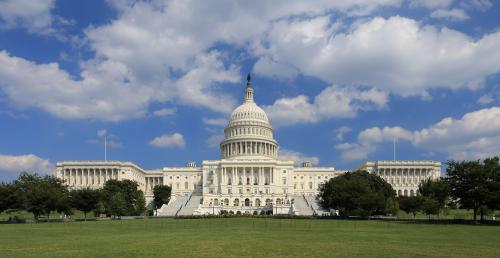The fiscal outlook for the United States is not promising, and it is likely to get worse soon.
At 77 percent of GDP, federal debt is already the highest relative to the economy in U.S. history except for a few years around World War II. Additionally, we are on the cusp of the full-on retirement of the Baby Boom generation, which will increase spending on Social Security and Medicare. Our most recent current policy projections with Alan Auerbach imply that the debt will rise to 93 percent of GDP by 2026 and 150 percent by 2046, even if we assume the economy is near full-employment the entire time and we fight no new wars. These projections also assume there are no new major changes to taxes or spending. The rising debt will crowd out investment and stymie growth in the long-term.
At present, low interest rates – the one silver lining in the projections – suggest that the crowding effect is minimal. But there are clouds on that horizon, too. First, the Fed recently announced an increase in the federal funds rate of 25 basis points. This still leaves the U.S. with low interest rates. But historically, when the Fed has begun raising interest rates, it often follows up with a succession of rate increases. Second, even if the Fed increase was undone and rates stayed constant over time, debt would still rise to about 119 percent of GDP by 2046.
Events in 2017 are likely to make the fiscal outlook more troubling. With the election of Donald Trump as president and the Republicans’ retention of a majority in the Senate and the House, major tax changes seem likely. Donald Trump and the House Republicans have proposed tax plans that would reduce revenues by $6.0 trillion and $2.5 trillion, respectively, according to Tax Policy Center and Penn-Wharton Budget Model estimates, even after accounting for effects on economic growth. But leading Republicans have sent mixed signals about how big a tax cut, if any, will be, with some Congressional leaders suggesting their plan will be revenue neutral, and Trump claiming that economic growth would reduce the cost of his plan to $2.6 trillion and that the revenue losses would be made up for via spending reforms, trade, energy programs, and regulatory reform.
The Committee for a Responsible Federal Budget estimates that Trump’s tax and spending proposals – the latter including replacing the Affordable Care Act, modifying Medicaid, boosting military spending, and enacting savings in non-defense programs – imply that the debt will rise to 105 percent of GDP by 2026. The CRFB report leaves out any estimate of increased infrastructure spending, which Trump has said he would like to increase by roughly $1 trillion over a decade. Including that would add further to the debt figures.
The basic conclusion is that the fiscal outlook will deteriorate in 2017, but there are a couple of wildcards, too. First, it is not clear by how much – that is, it is not clear how aggressive Trump and Congressional Republicans will be in pursuing tax cuts as opposed to structural reforms and increased spending – though one suspects that tax changes and repeal of Obamacare will be high on their list. Second, the Republicans have railed against debt limit increases in recent years. How they address that issue – which they will likely face as early as March – could change the fiscal course. Financial markets currently seem unconcerned about these fiscal prospects, but that could change abruptly.






Commentary
Op-ed2017’s fiscal outlook is unpromising
December 20, 2016